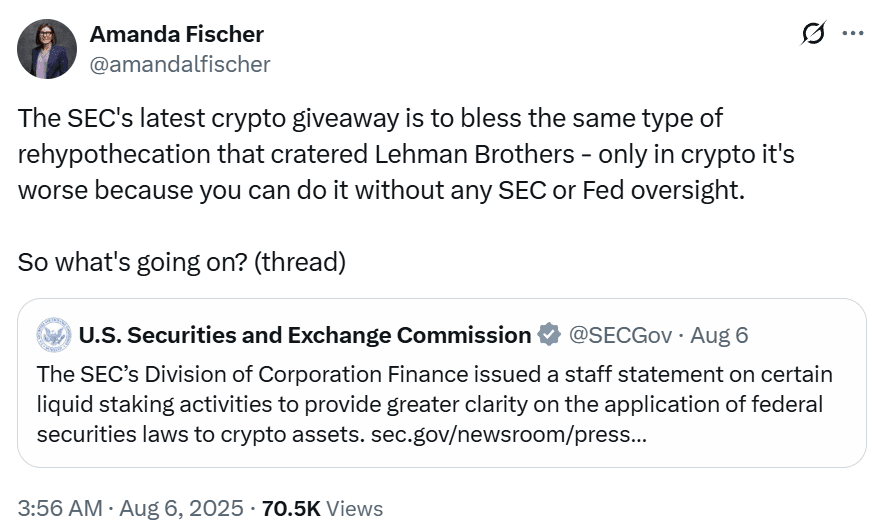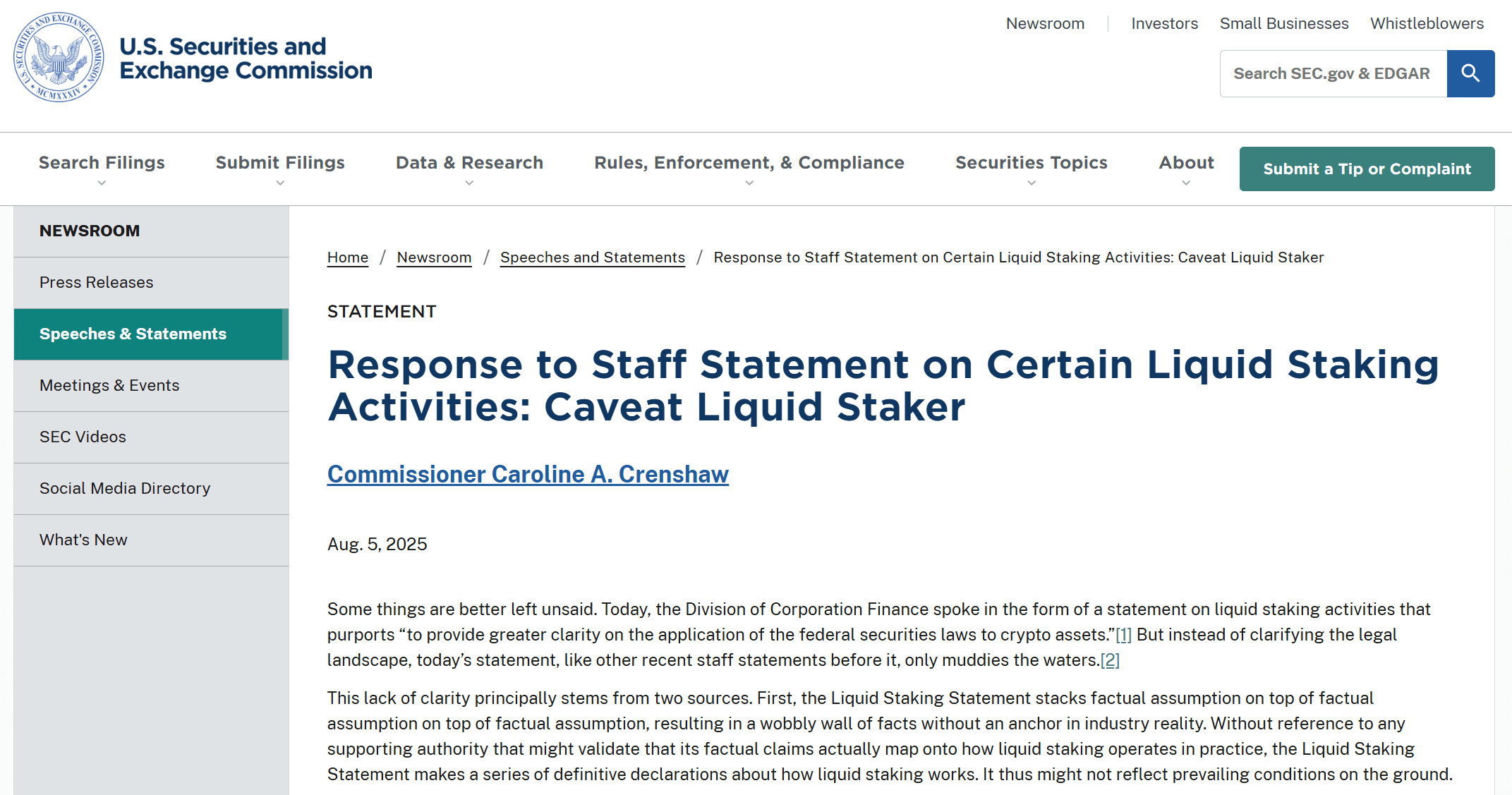A recent employee statement from the U.S. Securities and Exchange Commission (SEC) regarding liquid staking was originally intended to clarify how federal securities law applies to such crypto mechanisms, but it has sparked a huge uproar within the industry and regulatory bodies.
From former SEC Chairman Gary Gensler's chief of staff Amanda Fischer to current commissioner Caroline A. Crenshaw, and to the entire crypto industry participants, the debate surrounding 'whether liquid staking equates to the risks of the 2008 financial crisis' has evolved into a typical 'regulation versus innovation' struggle.
The spark that ignited the controversy
This statement places liquid staking within the framework of federal securities law, raising concerns from traditional finance backgrounds including former SEC chief of staff Amanda Fischer. Fischer stated on Twitter that liquid staking is highly similar to the 'rehypothecation' mechanism before the collapse of Lehman Brothers, believing it represents a 'high-risk' re-emergence.

Subsequently, Fischer suggested that the main concerns brought about by liquid staking include:
Assets may be 're-staked' across multiple protocols, leading to leverage risks;
Reliance on third-party intermediaries may trigger a chain reaction if the intermediaries fail;
The withdrawal process from staking has delays (for example, ETH must wait 11 days), exacerbating difficulties in withdrawing funds during a crisis;
Lack of disclosure, regulation, and inspection mechanisms, unlike traditional securities markets.
She ultimately criticized the SEC's statement as 'implicitly condoning high-risk structures,' and due to the lack of a central bank or regulatory safety net in the crypto ecosystem, such risks may be even harder to control.
Industry rebuttal: This is a 'misunderstanding' or 'deliberate misleading'
Fischer's comments quickly drew backlash from the industry. A crypto user responded on X, stating that it was 'highly misleading' and may have completely misunderstood the operating logic of liquid staking.

Matthew Sigel of VanEck, Mert Mumtaz of Helius Labs, Joe Doll of Magic Eden, and others have also spoken out, with core views including:
The transparency of blockchain can effectively control risks;
Liquid staking is inherently different from Lehman-style leverage, especially in the non-leveraged 'passive staking' mechanism;
Fischer's attempt to apply traditional financial models to decentralized systems is an inappropriate risk analogy.
This series of counterattacks highlights the industry's deep dissatisfaction with the 'traditional financial discourse dominating the regulatory framework.'
Voices of reflection from within the SEC
More importantly, there are voices of dissent within the SEC itself regarding this statement. Commissioner Caroline A. Crenshaw issued a statement on the official website on August 5, criticizing the guidance as 'misleading' and failing to provide clear direction, instead creating more uncertainty.

Crenshaw pointed out:
The guidance is based on multiple unverified assumptions (as indicated in footnotes n.11, n.18, n.24);
The so-called 'legal conclusion' only holds under specific hypothetical conditions;
The statement represents individual employee opinions and does not reflect the official position of the SEC Commission;
She even warned that participants in liquid staking need to 'exercise caution.'
This position differs from Fischer's 'high-risk warning' and leans more towards questioning the SEC's internal guidance mechanisms.
Deeper meaning: Is the regulatory logic losing focus, or is it a risk reminder?
The regulatory debate surrounding liquid staking essentially reveals the fundamental gap in 'understanding structure' between policymakers and the industry:
Regulators are concerned about the repetition of systemic risks; meanwhile, industry participants emphasize that the blockchain mechanism itself has risk mitigation capabilities; within the SEC, there are also doubts about the legal logic and scope of application of the current statement.

Although Fischer's analogy to Lehman Brothers has a cautionary significance, it is seen by the industry as 'overgeneralizing'; Crenshaw's criticism indicates that even within the SEC, there are reservations about the accuracy and applicability of the statement.
Summary
Regardless of how this controversy is interpreted, the regulatory issues surrounding liquid staking can no longer be ignored. It concerns not only technical implementation and asset security but also represents a direct collision between 'old financial logic' and 'new financial realities' as the U.S. formulates crypto asset policies.
The future direction of regulation may depend on whether such differences can be effectively resolved through cross-border understanding and communication, rather than remaining trapped in the path dependency of 'replicating traditional financial risk management templates.'

